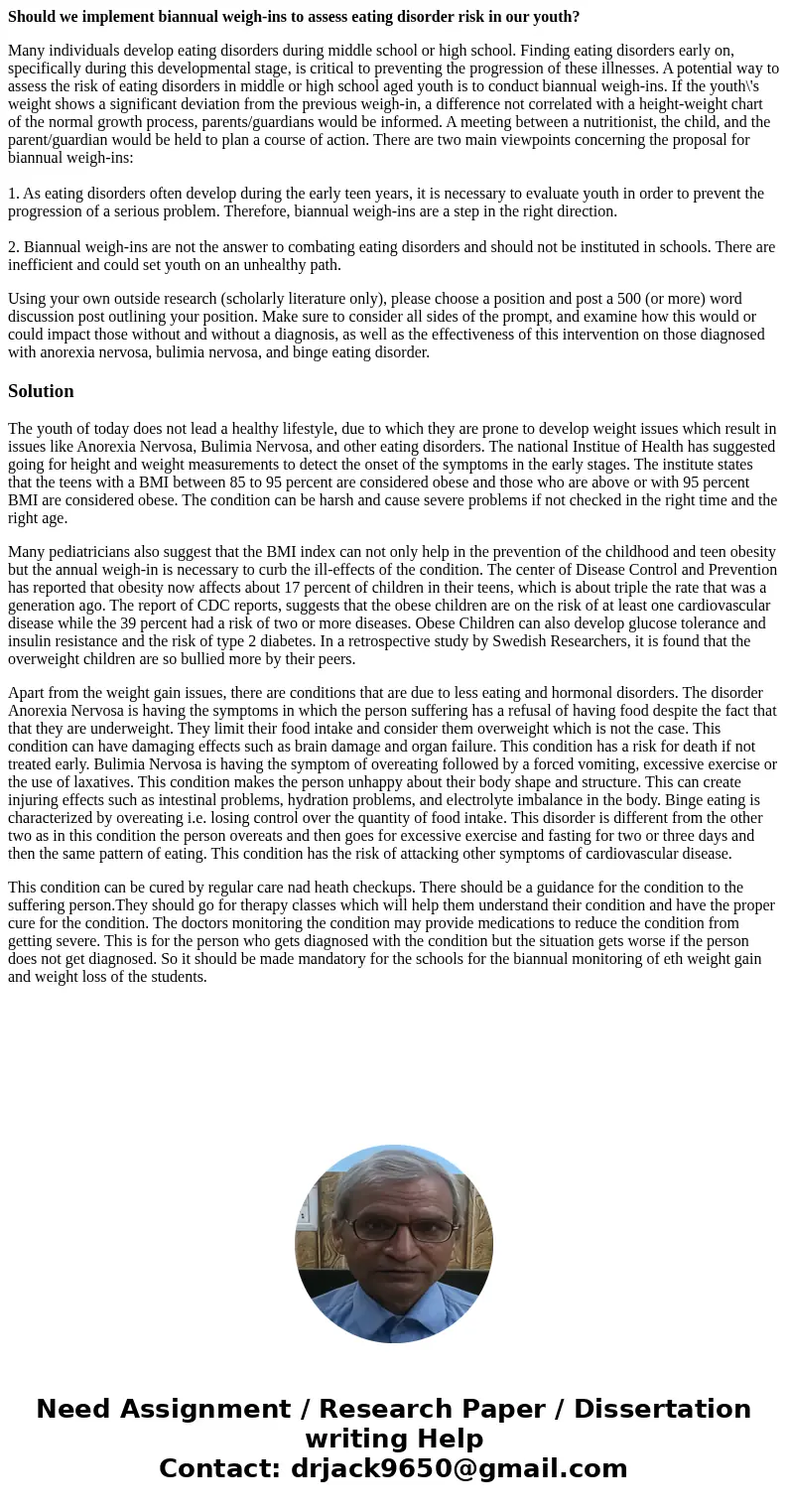Should we implement biannual weighins to assess eating disor
Should we implement biannual weigh-ins to assess eating disorder risk in our youth?
Many individuals develop eating disorders during middle school or high school. Finding eating disorders early on, specifically during this developmental stage, is critical to preventing the progression of these illnesses. A potential way to assess the risk of eating disorders in middle or high school aged youth is to conduct biannual weigh-ins. If the youth\'s weight shows a significant deviation from the previous weigh-in, a difference not correlated with a height-weight chart of the normal growth process, parents/guardians would be informed. A meeting between a nutritionist, the child, and the parent/guardian would be held to plan a course of action. There are two main viewpoints concerning the proposal for biannual weigh-ins:
1. As eating disorders often develop during the early teen years, it is necessary to evaluate youth in order to prevent the progression of a serious problem. Therefore, biannual weigh-ins are a step in the right direction.
2. Biannual weigh-ins are not the answer to combating eating disorders and should not be instituted in schools. There are inefficient and could set youth on an unhealthy path.
Using your own outside research (scholarly literature only), please choose a position and post a 500 (or more) word discussion post outlining your position. Make sure to consider all sides of the prompt, and examine how this would or could impact those without and without a diagnosis, as well as the effectiveness of this intervention on those diagnosed with anorexia nervosa, bulimia nervosa, and binge eating disorder.
Solution
The youth of today does not lead a healthy lifestyle, due to which they are prone to develop weight issues which result in issues like Anorexia Nervosa, Bulimia Nervosa, and other eating disorders. The national Institue of Health has suggested going for height and weight measurements to detect the onset of the symptoms in the early stages. The institute states that the teens with a BMI between 85 to 95 percent are considered obese and those who are above or with 95 percent BMI are considered obese. The condition can be harsh and cause severe problems if not checked in the right time and the right age.
Many pediatricians also suggest that the BMI index can not only help in the prevention of the childhood and teen obesity but the annual weigh-in is necessary to curb the ill-effects of the condition. The center of Disease Control and Prevention has reported that obesity now affects about 17 percent of children in their teens, which is about triple the rate that was a generation ago. The report of CDC reports, suggests that the obese children are on the risk of at least one cardiovascular disease while the 39 percent had a risk of two or more diseases. Obese Children can also develop glucose tolerance and insulin resistance and the risk of type 2 diabetes. In a retrospective study by Swedish Researchers, it is found that the overweight children are so bullied more by their peers.
Apart from the weight gain issues, there are conditions that are due to less eating and hormonal disorders. The disorder Anorexia Nervosa is having the symptoms in which the person suffering has a refusal of having food despite the fact that that they are underweight. They limit their food intake and consider them overweight which is not the case. This condition can have damaging effects such as brain damage and organ failure. This condition has a risk for death if not treated early. Bulimia Nervosa is having the symptom of overeating followed by a forced vomiting, excessive exercise or the use of laxatives. This condition makes the person unhappy about their body shape and structure. This can create injuring effects such as intestinal problems, hydration problems, and electrolyte imbalance in the body. Binge eating is characterized by overeating i.e. losing control over the quantity of food intake. This disorder is different from the other two as in this condition the person overeats and then goes for excessive exercise and fasting for two or three days and then the same pattern of eating. This condition has the risk of attacking other symptoms of cardiovascular disease.
This condition can be cured by regular care nad heath checkups. There should be a guidance for the condition to the suffering person.They should go for therapy classes which will help them understand their condition and have the proper cure for the condition. The doctors monitoring the condition may provide medications to reduce the condition from getting severe. This is for the person who gets diagnosed with the condition but the situation gets worse if the person does not get diagnosed. So it should be made mandatory for the schools for the biannual monitoring of eth weight gain and weight loss of the students.

 Homework Sourse
Homework Sourse